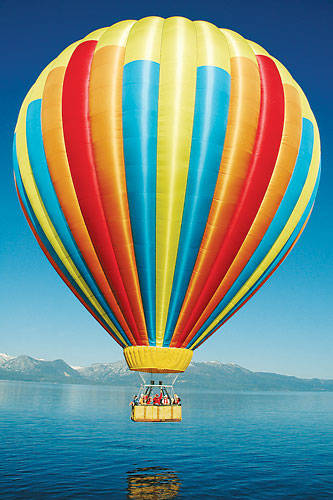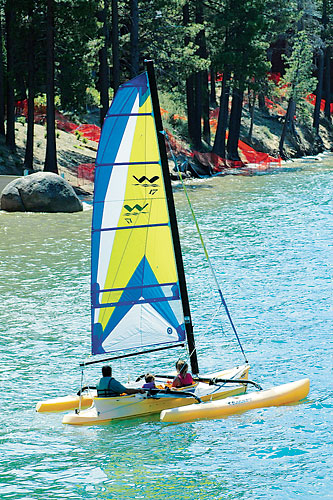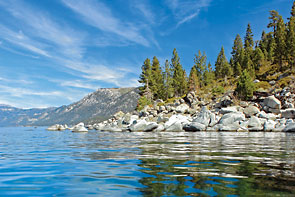It was 4 a.m. when we got the word that our flight was a go. By 5:30, our ship, the Tahoe Flyer, the world’s only United States Coast Guard-certified balloon launch and recovery aircraft carrier vessel, moved over the glassy water toward the center of the lake as a rising sun burnt an orange arch behind the mountain peaks. The crew went through its choreographed duties like a well-oiled machine, and by 7:30, we were drifting at around 9,000 feet, nearly 3,000 feet above the cobalt waters of Lake Tahoe, aptly called the “Jewel of the Sierra.”
From our vantage point on that clear summer day, we could see it all: golf courses, campgrounds, mansions, casinos, ski resorts and long, sandy beaches. Just before our landing back on the deck of the Tahoe Flyer, our pilot demonstrated his command of the balloon by actually touching down on the water and lifting off again.
We had come to Tahoe to rediscover the seemingly infinite recreation possibilities of  this playground shared by both California and Nevada. We started at South Lake Tahoe at the modern Zephyr Cove RV Resort and Lodge, which was close to many attractions — including big-name entertainment clubs like Harrah’s and Harvey’s — golf courses,
this playground shared by both California and Nevada. We started at South Lake Tahoe at the modern Zephyr Cove RV Resort and Lodge, which was close to many attractions — including big-name entertainment clubs like Harrah’s and Harvey’s — golf courses,
fishing and all the water sports you can imagine. Zephyr Cove is also the dock for the M.S. Dixie II stern-wheeler. A sunset dinner and dance cruise on the Dixie was a wonderful way to see the lake from a different perspective.
The next morning we headed back into town to check out more of South Lake Tahoe. An early half-day fishing trip with Tahoe Sportfishing assured us of dinner. Dropping down to about 200 feet with depth-coded color line, we all “limited out” on the fish the lake is famous for: Mackinaw and rainbow trout.
From out on the water, we noticed the Heavenly Valley Gondola creeping ant-like up the face of the mountain. We had skied here many times. The base of the gondola is located in Heavenly Village, right on Highway 50 near the town of Stateline. On the way up there are incredible views, and you can get out on the deck and enjoy a drink or snack at the café.
A mile or so west of Stateline on Highway 50, we stopped at Timber Cove Marina. After a relaxing lunch at the Blue Water Bistro, perched over the water on the Boardwalk Pier, we took to the air again behind one of the marina’s high-speed parasailing boats. Harnessed to a powerful winch and parachute, we lifted off from the back of the boat, and after soaring 1,200 feet over the water, we gently landed right back where we started.
Lake Tahoe is the third deepest lake in North America, with a maximum depth of 1,685 feet. It was home to the Washoe Indians for centuries before white men arrived. Archaeologists believe that the first people came to the area at least 10,000 years ago. During the mid-1800s, California’s gold rush and the Comstock Lode brought hordes of miners and loggers to the area.
It didn’t take long for the wealthy to learn about Tahoe’s natural beauty. Lavish resorts and magnificent mansions sprang up around the shore. Today, many of those are open to the public. An easy bike trail leads to the Tallac Historic Site, Baldwin Estate, Pope Estate and the Valhalla Estate. Wandering along the Tallac Historic Trail through the gardens and passing by museums and the interpretive center gave us a glimpse of the lavish lifestyle enjoyed at these “summer homes.”
Looking for some quiet camping in the forest, we pulled into the historic Camp Richardson, just outside of South Lake Tahoe. Many of the rustic sites under the forest of giant old-growth Sugar Pines are as they were 30 or 40 years ago. Camp Richardson is just across the highway from the paved bike and foot trail to the Taylor Creek visitors center, where we found ample parking for RVs.
Driving north on Highway 89 can be a challenge with a big trailer or motorhome. Parking is limited and there are some steep 15-mph corners. That said, the highway is a beautiful scenic route along the lakeshore, and RVers manage to regularly traverse the road. We stopped at the Emerald Bay overlook — the parking lot is small and fills up quickly, so get an early start — and walked down to the spectacular Vikingsholm. This 38-room Scandinavian-style castle of stone and
hand-carved timbers is quite impressive, nestled as it is at the end of Emerald Bay — truly a jewel within a jewel.
With Desolation Wilderness as a backdrop, there are hundreds of miles of trails for the day-tripper and the avid backpacker. One of the most beautiful is the walk along the lake from Emerald Bay to D.L Bliss State Park. It was an easy round trip with a lunch stop, and a bus — the Nifty Fifty Trolley — shuttles people back to Emerald Bay and Camp Richardson, and points of interest in between.
Highway 89 winds along the lake with magnificent views of the shoreline. Soon we came to Sugar Pine Point, another of those “summer home” estates that is now a state park. The pier at Sugar Pine Point begs for a picnic, and the adjacent campground is one of the nicest in the Tahoe area. A little farther north, just past Tahoma, we found the turnoff for the McKinney-Rubicon road. Following it up to a parking lot, the pavement turns to dirt, and soon degrades to a Jeep trail leading to Rubicon Springs, home of the famous Jeeper’s Jamboree. Tahoe Adventures leads day trips on ATVs into the springs, providing an easy and safe way to experience the backcountry.
Tahoe City has all the amenities that the traveler needs, including supermarkets, sporting-goods stores and specialty shops. On Thursdays a farmers’ market is on the waterfront park and beach. Just around the corner, Fanny Bridge spans the Truckee River, Lake Tahoe’s only outlet. If you lean over the railing to watch the big trout swimming below, you’ll show passers-by why it’s called Fanny Bridge.
There is plenty of room for big RVs in the huge public parking lot south of the bridge. A paved bike trail follows the Truckee River all the way down to the River Ranch and on to Squaw Valley, home of the 1960 Winter Olympics. It was an easy 7- or 8-mile ride to the Squaw Valley Village.
From the valley floor, we boarded the Squaw Valley Cable Car, which ascends 2,000 feet to High Camp at 8,200 feet. Here, with a view unmatched by only the top of the Heavenly Valley Gondola, there is a jacuzzi, heated swimming pool, Olympic-sized ice rink, tennis courts, restaurants, bars and an interesting VIII Winter Olympic Games Museum. There are special events such as full-moon hikes and sunset dinners overlooking Lake Tahoe.
Back in Tahoe City, we parked with a few other RVs in the lot south of Fanny Bridge. While not an official camping site, overnight parking is permitted, and many people use it as a starting point for the recently completed Tahoe Rim Trail. Passing through two states, six counties, three national forests and three wilderness areas, this 165-mile single track completely circles Lake Tahoe. Since parking can be difficult in town, you can walk there or take the Tahoe Trolley, which makes frequent stops.
We wanted to see some of the lavish multimillion dollar lakeshore homes up close from the water, so we rented kayaks at Tahoe City Kayak and made a leisure paddle along the shore to Sunnyside Marina, Lodge and Restaurant for lunch.
Now turning northeast on Highway 28, we drove past an endless string of condos and resorts as we made our way across the California/Nevada state line to Incline Village. Of all the lakeside mansions, perhaps the most famous is the Thunderbird Lodge, built in 1936 by San Francisco millionaire George Whittell. Mr. Whittell, otherwise known as “The Captain,” owned 40,000 acres and 24 miles of the Nevada shoreline, which thankfully he never took time to develop. The lodge is nestled among pine forests and huge granite boulders.
With our guide, we followed in the footsteps of George Whittell and his pet lion through the secret 600-foot underground tunnel connecting the main lodge with the boathouse where the magnificent 55-foot Thunderbird yacht is still moored. Completed at a cost of $87,000, though today it costs much more, Whittell took delivery of the Thunderbird in 1940. It first crossed the mountain lake’s sparkling blue waters on July 14 of that year. The original Kermath engines were replaced with two V-12 Allison aircraft engines, each capable of 1,200 horsepower.
Continuing south to Highway 50 and returning to our starting point at the Zephyr Cove RV Resort, we had only touched on the highlights of Lake Tahoe. It left me again wondering what early explorers must have thought when they came upon this “Jewel of the Sierra.”
Sources
Lake Tahoe Balloons, (530) 544-1221, www.laketahoeballoons.com.
Heavenly Mountain Resort, (775) 586-7000, www.skiheavenly.com.
North Lake Tahoe Visitors Bureau, (888) 434-1262, www.gotahoenorth.com.
Lake Tahoe Visitors Authority, (800) 288-2463, www.tahoesouth.com.
Thunderbird Lodge Preservation Society, (775) 832-8750, www.thunderbirdlodge.org.

